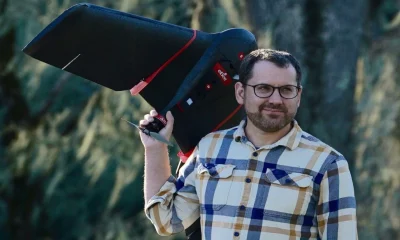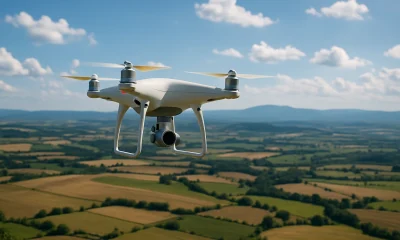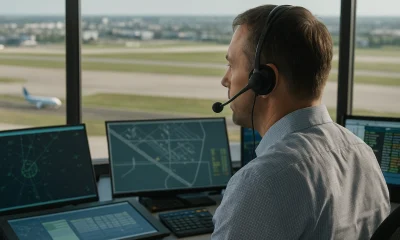- Acronym Guide
- AAM
- ABS
- AC
- ACAS
- ADS-B
- AEHF
- AFAC
- AGL
- AI
- AIM
- ALPA
- ALS
- AM
- AMA
- ANSP
- AOI
- APPI
- AUV
- AUVSI
- ARPAS-UK
- ASTM
- ATC
- ATO
- BLOS
- BVLOS
- CAA
- CAAC
- CAB
- CAP
- CASA
- CATT
- CBO
- CBR
- CBRN
- CDMA
- CDR
- CFI
- CFR
- CIR
- COA
- COMINT
- CORS
- COTP
- COTR
- CPTED
- CV
- C2
- DAA
- DAS
- DEM
- DFI
- DFS
- DGCA
- DHS
- DOD
- DPA
- DPEs
- DRG
- DRO
- DSM
- DSMX
- DSP
- DSSS
- DTM
- EASA
- EFT
- EO
- EOD
- EO/IR
- ELINT
- EMI
- ESC
- EVLOS
- eVTOLs
- FAA
- FCC
- FCS
- FHSS
- FICCI
- FLIR
- FOB
- FOV
- FPS
- FPV
- GBDAA
- GCP
- GCS
- GDPR
- GML
- GNSS
- GPS
- GSD
- GVC
- HDR
- HOGE
- IACRA
- ICAO
- ICS
- IED
- IMU
- INS
- IR
- ISA
- ISR
- ITU
- JARUS
- LAAMS
- LAANC
- LAATM
- LAI
- LAS
- LBA
- LIDAR
- LOS
- LSALT
- MAC
- MAVLink
- MLIT
- MMS
- MSL
- MTOM
- NDAA
- NCSL
- NFZ
- NIST
- NMEA
- NOTAM
- NPA
- NPRM
- NTIA
- OBIA
- OEM
- OFDM
- OGI
- OOP
- PAS
- PASM
- PAV
- PCV
- PdM
- PEC
- PIC
- PID
- PIPL
- PLD
- PM
- PN
- PPK
- PPS
- PSM
- PTZ
- PWM
- UAM
- UAOP
- UAS
- UASTM
- UAV
- UCAVs
- UHD
- UHF
- USV
- UTM
- RAIM
- RCC
- RCS
- RED
- ReOC
- RePL
- RFI
- RMS
- ROI
- RPAS
- RPC
- RTH
- RTN
- RTK
- SaR
- SAR
- SARP
- SBAS
- S.Bus
- SBIR
- SEDENA
- SfM
- SFOC
- SIGINT
- SLAM
- SMS
- SOP
- SORA
- STANAG
- STTR
- STK
- sUAS
- TCAS
- TCCA
- TFR
- TIN
- TLM
- TOF
- TP
- TPS
- TSA
- VHF
- VLOS
- VTOL
Drone Acronyms
What is VTOL (Vertical Take-Off and Landing) & How Does it Work?
By
Jacob StonerTable Of Contents

Definition
VTOL stands for Vertical Take-Off and Landing. It refers to aircraft that can take off, hover, and land vertically. This capability allows VTOL aircraft to operate in confined spaces without the need for long runways.
Relevance to the Industry
VTOL aircraft are critical in industries where space is limited or where rapid deployment is essential. In urban environments, VTOL drones can deliver packages directly to doorsteps or transport medical supplies quickly. In military and rescue operations, VTOL capabilities allow aircraft to operate in rough terrain or disaster-stricken areas without the need for prepared landing zones.
How Does a VTOL Work?
Vertical Takeoff and Landing (VTOL) aircraft are designed to take off, hover, and land vertically. This capability combines the vertical flight advantages of helicopters with the efficient forward flight of fixed-wing aircraft. Here’s an in-depth look at how VTOL aircraft work:
1. System Components
- Airframe: The structural body of the VTOL, designed to support vertical and horizontal flight. It can resemble a helicopter, a multicopter, or a hybrid design with both fixed wings and rotors.
- Propulsion System: Includes engines or electric motors with rotors, propellers, or tiltrotors that provide the necessary lift and thrust for both vertical and horizontal flight.
- Power Source: Typically batteries for electric VTOLs or fuel for combustion engines, providing the energy needed for all phases of flight.
2. Flight Mechanics
- Vertical Takeoff and Hovering:
- Rotor Configuration: In multicopters or helicopters, multiple rotors provide lift by generating downward thrust. In tiltrotor or hybrid designs, rotors can tilt to transition between vertical and horizontal flight.
- Stability Control: Advanced gyroscopes and accelerometers help maintain stability and balance during vertical takeoff and hovering.
- Transition to Forward Flight:
- Tiltrotors: Engines or rotors tilt from a vertical to a horizontal position, transitioning from lifting the aircraft vertically to propelling it forward.
- Fixed-Wing Mode: For hybrid designs, once the aircraft reaches a certain altitude, the fixed wings provide lift, and the rotors generate forward thrust.
- Horizontal Flight: In this phase, the aircraft operates similarly to a conventional fixed-wing airplane, with wings providing lift and engines or propellers providing forward thrust.
- Vertical Landing: The transition from horizontal flight back to vertical descent involves reducing forward speed and reorienting the rotors or engines to a vertical position for controlled landing.
3. Navigation and Control Systems
- Autopilot System: Onboard computers manage the flight path, altitude, and speed, ensuring smooth transitions between vertical and horizontal flight modes. They rely on input from GPS, gyroscopes, and accelerometers.
- Manual Control: Pilots can control the VTOL aircraft through a remote control interface or onboard controls, sending commands to adjust altitude, speed, and direction.
4. Communication Systems
- Data Link: Enables real-time communication between the VTOL aircraft and the ground control station (GCS) or pilot, transmitting telemetry data and receiving control inputs.
- Telemetry System: Provides real-time feedback on the aircraft’s status, position, speed, and environmental conditions, crucial for safe operation.
5. Operational Phases
- Pre-Flight Planning: Operators define the mission, including takeoff and landing zones, flight path, and specific tasks. This information is programmed into the autopilot system.
- Takeoff and Launch: The VTOL aircraft ascends vertically from a stationary position, using its rotors or tiltrotors to lift off the ground.
- Transition to Forward Flight: Once at the desired altitude, the aircraft transitions to forward flight, with the rotors or tiltrotors shifting to propel the aircraft horizontally.
- Mission Execution: The aircraft follows the planned flight path, performing tasks such as data collection, surveillance, or transportation. Operators can monitor and adjust the flight in real time.
- Transition to Vertical Descent: As the mission concludes, the aircraft transitions back to vertical flight, slowing down and descending to the landing zone.
- Landing and Recovery: The VTOL aircraft lands vertically, using its rotors or tiltrotors to control the descent and ensure a smooth touchdown.
6. Applications and Use Cases
- Urban Air Mobility: Providing rapid, efficient transportation within urban areas, reducing congestion and travel time.
- Emergency Response: Delivering medical supplies, equipment, and personnel to disaster zones or hard-to-reach areas.
- Surveillance and Security: Monitoring large areas for security purposes, border patrol, and law enforcement.
- Environmental Monitoring: Collecting data on weather, climate, and wildlife in remote or inaccessible areas.
- Infrastructure Inspection: Inspecting power lines, pipelines, and bridges, especially in challenging terrains.
Understanding the workings of VTOL aircraft reveals their advanced technology and versatile capabilities, showcasing their potential to revolutionize transportation and various industries.
Example in Use
“Urban air mobility solutions are increasingly relying on VTOL technology to develop air taxis that can efficiently navigate congested cities.”
Frequently Asked Questions about VTOL (Vertical Take-Off and Landing)
1. What is a VTOL aircraft?
Answer: A VTOL aircraft is an aircraft that has the capability to take off, hover, and land vertically. This includes helicopters, some fixed-wing aircraft with specialized engines or rotors, and various types of drones. VTOL technology allows these aircraft to operate in confined spaces and areas without traditional runways, making them versatile for a wide range of applications.
2. How does VTOL work?
Answer: VTOL aircraft use different technologies to achieve vertical take-off and landing:
- Rotary-Wing Aircraft (Helicopters): Use rotors to generate lift vertically.
- Tilt-Rotor Aircraft: Combine features of helicopters and fixed-wing aircraft, with rotors that tilt to provide both vertical lift and forward thrust.
- Fixed-Wing VTOL Aircraft: Use jet engines or rotating engines that direct thrust downwards for vertical lift and transition to horizontal flight for forward motion.
By leveraging these technologies, VTOL aircraft can transition smoothly between vertical and horizontal flight, allowing for flexible and efficient operations.
3. What are the advantages of VTOL aircraft?
Answer: The advantages of VTOL aircraft include:
- Operational Flexibility: Ability to take off and land in confined spaces without the need for runways.
- Accessibility: Can reach remote or urban areas that are inaccessible to conventional aircraft.
- Efficiency: Reduces the need for infrastructure such as runways and helipads.
- Rapid Deployment: Ideal for emergency response and military operations where speed and maneuverability are critical.
These benefits make VTOL technology valuable across various sectors, including transportation, logistics, defense, and emergency services.
For examples of these acronyms visit our Industries page.
As the CEO of Flyeye.io, Jacob Stoner spearheads the company's operations with his extensive expertise in the drone industry. He is a licensed commercial drone operator in Canada, where he frequently conducts drone inspections. Jacob is a highly respected figure within his local drone community, where he indulges his passion for videography during his leisure time. Above all, Jacob's keen interest lies in the potential societal impact of drone technology advancements.
Pros
Cons
You may like


Gregory Crutsinger, Founder of Scholar Farms – Innovator Series


What is RED (Rapid Extraction Device) & How Does it Work?


What is IED (Improvised Explosive Device) & How Does it Work?


What is BLOS (Beyond Line of Sight) & How Does it Work?


What is ATO (Authority to Operate) & How Does it Work?


What is ALPA (Air Line Pilots Association) & How Does it Work?